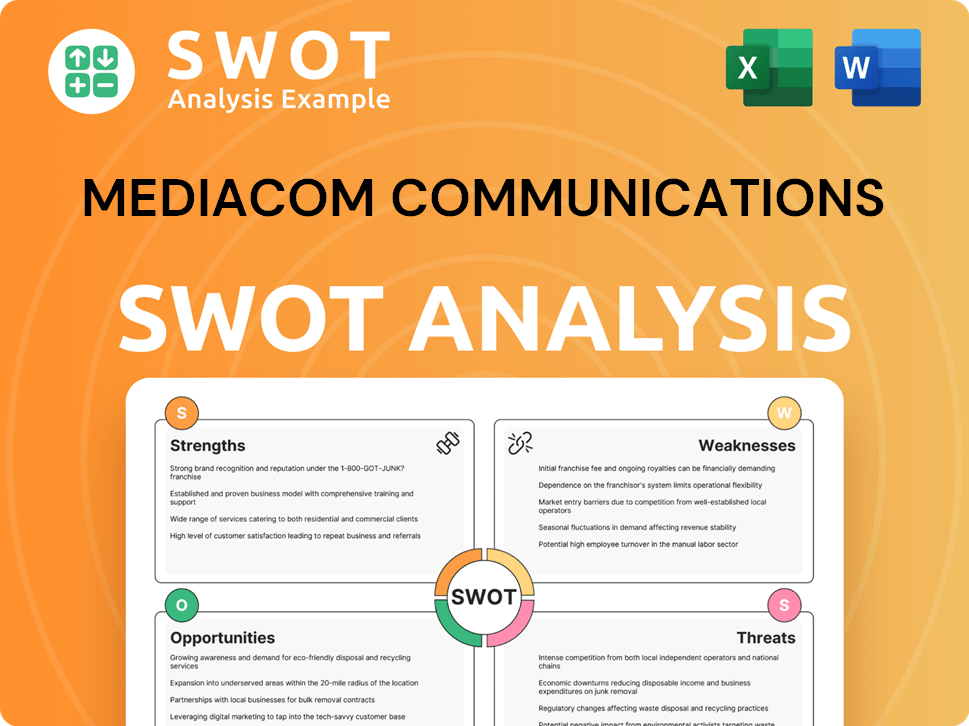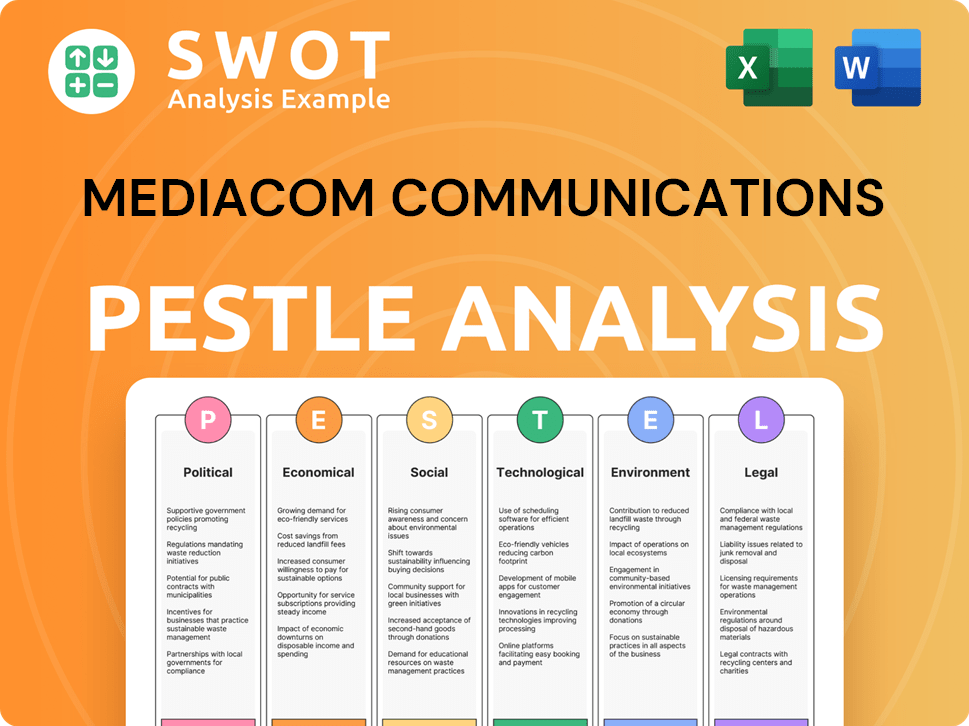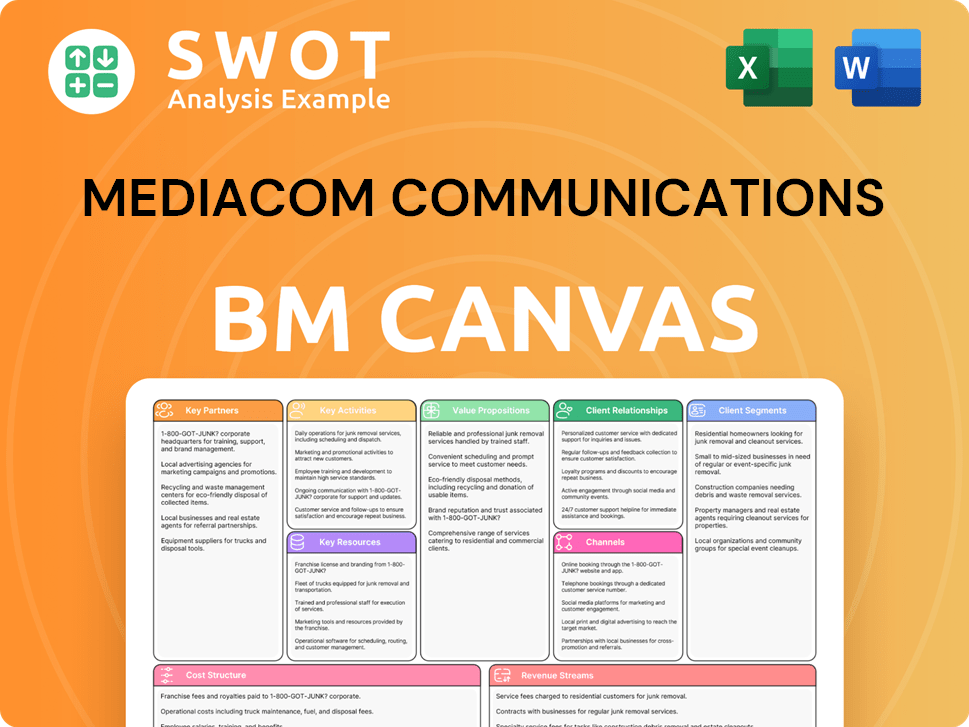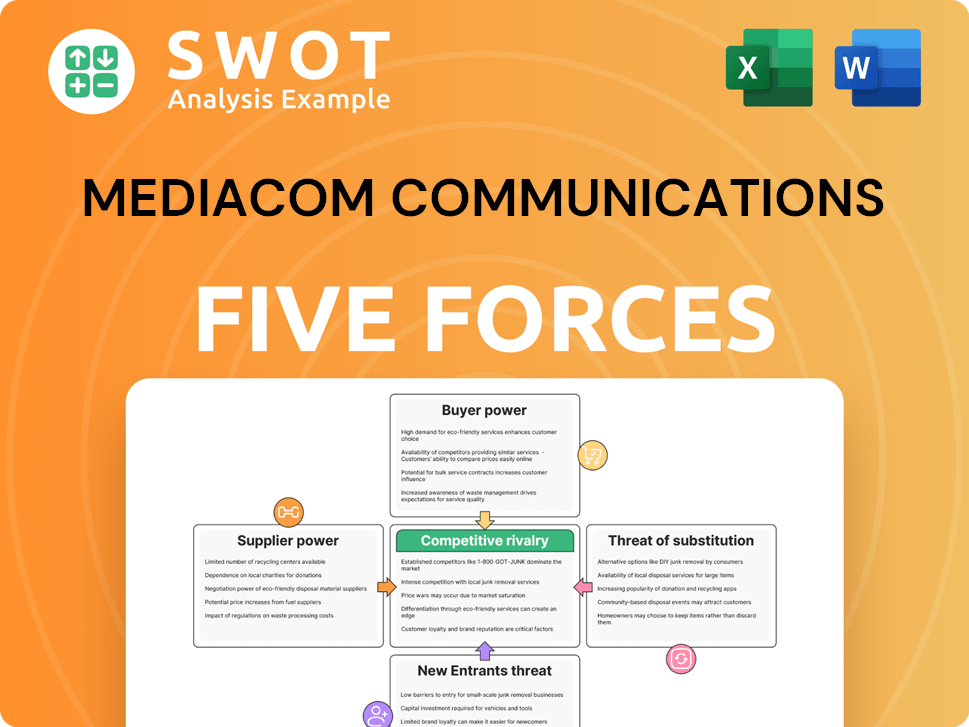Mediacom Communications Bundle
How did Mediacom Communications become a major player in the telecom industry?
Discover the compelling story of Mediacom Communications, a company that defied industry giants to serve overlooked communities. From its humble beginnings in 1995, Mediacom, founded by Rocco B. Commisso, strategically targeted smaller cities and towns. This focus allowed Mediacom to build a loyal customer base and establish a strong presence in the American telecommunications landscape.

This brief history of Mediacom Communications explores its Mediacom Communications SWOT Analysis, early years, and expansion over time, highlighting its commitment to bridging the digital divide. Learn about the Mediacom founder's vision and how Mediacom services, including cable television, internet, and phone, transformed the telecom industry. Today, Mediacom stands as a testament to strategic market penetration and sustained growth.
What is the Mediacom Communications Founding Story?
The Mediacom Communications story began on July 1, 1995. Rocco B. Commisso, the Mediacom founder, established the company with a clear vision. He aimed to serve smaller cities and towns by acquiring and upgrading their cable systems.
Commisso, with his extensive experience in finance and cable television, saw an opportunity in underserved markets. His strategy involved buying outdated cable systems and investing in infrastructure. This approach quickly established Mediacom's presence in various communities, offering advanced services.
The initial funding came from private equity and debt financing. Commisso's network and financial skills were crucial in securing these funds. The name 'Mediacom' was chosen to reflect its core business. The founding team's expertise in both finance and cable operations was key to navigating acquisitions and technological upgrades.
Mediacom's early focus was on acquiring and upgrading cable systems. This involved significant investment in infrastructure to provide enhanced services. The company expanded its services to include internet access and phone services.
- Mediacom's initial acquisitions focused on smaller markets.
- The company invested in infrastructure upgrades.
- Mediacom expanded its services beyond cable TV.
- Financial backing came from private equity and debt.
Mediacom Communications SWOT Analysis
- Complete SWOT Breakdown
- Fully Customizable
- Editable in Excel & Word
- Professional Formatting
- Investor-Ready Format

What Drove the Early Growth of Mediacom Communications?
The early growth of Mediacom Communications, a key part of the Mediacom history, was marked by an aggressive acquisition strategy. This strategy focused on smaller cable systems, particularly in the Midwest and Southeast regions. The company quickly expanded its reach after its founding, acquiring numerous cable systems to create operational efficiencies. By the end of 1996, Mediacom had already amassed over 100,000 subscribers.
Mediacom's early years were characterized by rapid expansion through acquisitions. The company targeted smaller, independently owned cable systems to increase its market presence. This strategy allowed Mediacom to quickly grow its subscriber base and expand its service areas. The acquisitions were often in contiguous geographical areas, which helped in creating operational efficiencies.
Early product launches focused on upgrading existing cable television offerings. These upgrades included more channels and improved signal quality, enhancing the customer experience. The company aimed to provide better services to its subscribers, setting the stage for future technological advancements. This focus helped establish Mediacom as a reliable service provider.
A significant turning point for Mediacom Communications came with the introduction of high-speed internet services in the late 1990s. Recognizing the growing demand for internet access, Mediacom invested heavily in upgrading its infrastructure to support broadband connectivity. This strategic move allowed the company to diversify its revenue streams beyond traditional cable television.
By 2000, Mediacom had grown to serve over 1 million customers, demonstrating its rapid growth. Key acquisitions during this period included numerous smaller cable operators, consolidating its presence in its target markets. This expansion solidified Mediacom's position as a major provider in non-metropolitan regions. For more insights, explore the Competitors Landscape of Mediacom Communications.
Mediacom Communications PESTLE Analysis
- Covers All 6 PESTLE Categories
- No Research Needed – Save Hours of Work
- Built by Experts, Trusted by Consultants
- Instant Download, Ready to Use
- 100% Editable, Fully Customizable

What are the key Milestones in Mediacom Communications history?
The Mediacom Communications company has a rich history, marked by significant milestones that have shaped its trajectory in the telecommunications industry. From its founding to its current status, Mediacom has consistently adapted to market changes and technological advancements, solidifying its position as a key player in providing essential services, especially in smaller markets.
| Year | Milestone |
|---|---|
| 1995 | Mediacom Communications was founded by Rocco B. Commisso. |
| 1999 | Mediacom went public, marking a significant step in its expansion and growth strategy. |
| Early 2000s | Mediacom began its transition from a cable TV provider to a comprehensive communications company, focusing on high-speed internet services. |
| 2011 | Mediacom launched its DOCSIS 3.0 network, significantly increasing internet speeds. |
| 2016 | Mediacom announced its acquisition by a private equity firm, marking a shift in ownership. |
| Early 2024 | Mediacom expanded its 1-gigabit internet service availability to nearly 90% of its footprint, with plans for 2-gigabit and 10-gigabit services. |
Mediacom has been at the forefront of technological advancements, particularly in the realm of high-speed internet. The company has consistently invested in its network infrastructure, deploying DOCSIS 3.1 and fiber-to-the-home (FTTH) technology to deliver multi-gigabit internet speeds to its customers.
Mediacom was an early adopter of high-speed internet services, transforming from a cable TV provider to a comprehensive communications company. This strategic move allowed Mediacom to capitalize on the growing demand for broadband.
Mediacom deployed DOCSIS 3.1 technology to enhance its network capabilities. This upgrade allowed for faster internet speeds and improved overall network performance.
Mediacom has expanded its fiber-to-the-home (FTTH) technology in select areas. This expansion provides multi-gigabit internet speeds, catering to the growing demand for high-speed connectivity.
The company has plans to introduce 2-gigabit and even 10-gigabit services in some markets. This positions Mediacom at the forefront of providing cutting-edge internet speeds.
Continuous investment in network infrastructure upgrades is a core strategy for Mediacom. These upgrades ensure that the company can meet the evolving needs of its customers.
Despite its achievements, Mediacom has faced several challenges, including intense competition and evolving consumer preferences. The company has adapted by focusing on internet services and continuously upgrading its network to meet customer demands.
Mediacom faces intense competition from satellite providers, telcos, and fixed wireless access (FWA) providers. This competition necessitates continuous innovation and strategic adjustments.
The shift from traditional linear TV to streaming services has required Mediacom to adapt its video offerings. This shift has led to a greater focus on internet services as a primary revenue driver.
Mediacom has faced public scrutiny regarding customer service and pricing. The company is continuously working to enhance customer satisfaction through various initiatives.
Economic downturns have necessitated strategic adjustments. The company has demonstrated resilience by continuously investing in network upgrades and expanding its service offerings.
Mediacom has shown its ability to adapt to a rapidly changing technological landscape. This adaptability is key to its continued success in the telecommunications industry.
Mediacom has reinforced its strength in providing essential services to smaller markets. This focus helps the company maintain a strong presence in areas often underserved by larger providers.
Mediacom Communications Business Model Canvas
- Complete 9-Block Business Model Canvas
- Effortlessly Communicate Your Business Strategy
- Investor-Ready BMC Format
- 100% Editable and Customizable
- Clear and Structured Layout

What is the Timeline of Key Events for Mediacom Communications?
The brief history of Mediacom Communications reflects a journey of strategic growth and technological adaptation. From its founding by Rocco B. Commisso, Mediacom has evolved from a cable provider to a significant player in the telecommunications industry, expanding its services and infrastructure over the years. Here's a look at the key milestones in the
| Year | Key Event |
|---|---|
| 1995 | Founded by Rocco B. Commisso, beginning acquisitions of cable systems in underserved markets. |
| Late 1990s | Began introducing high-speed internet services, diversifying its service offerings beyond traditional cable TV. |
| 2000 | Surpassed 1 million customers, demonstrating significant early growth and market penetration. |
| 2004 | Completed the initial rollout of digital cable services across its footprint. |
| 2010s | Accelerated network upgrades to DOCSIS 3.0, enabling faster internet speeds. |
| 2015 | Celebrated 20 years in business, highlighting its sustained presence in the industry. |
| Late 2010s - Early 2020s | Began significant investments in DOCSIS 3.1 and fiber-to-the-home (FTTH) deployments, aiming for multi-gigabit speeds. |
| 2024 | Continues to expand its gigabit-speed internet availability, reaching a substantial portion of its service areas. |
| 2025 and Beyond | Focus on further expanding fiber optic infrastructure, enhancing network capacity, and exploring new service offerings. |
Mediacom is strategically focused on expanding its fiber optic network, particularly in areas where it can deliver symmetrical multi-gigabit speeds. This expansion is crucial for meeting the increasing demand for high-speed internet. The company aims to position itself for future bandwidth-intensive applications and maintain its competitive edge in the market.
The increasing reliance on cloud services, the proliferation of IoT devices, and the growth of remote work and learning will continue to drive demand for robust broadband connectivity. Mediacom plans to capitalize on these trends by consistently upgrading its infrastructure and offering competitive service tiers. These upgrades are essential for meeting the evolving needs of its customers.
Analyst predictions suggest that regional providers like Mediacom, with strong local ties and a focus on infrastructure investment, are well-positioned to maintain their market share. They may also expand in areas underserved by larger national carriers. This strategic focus on infrastructure is key to long-term success.
Mediacom's forward-looking statements emphasize its commitment to providing reliable, high-quality connectivity to its communities. This aligns with Rocco B. Commisso's initial vision of bridging the digital divide in smaller markets. The company's focus remains on serving its customers effectively and efficiently.
Mediacom Communications Porter's Five Forces Analysis
- Covers All 5 Competitive Forces in Detail
- Structured for Consultants, Students, and Founders
- 100% Editable in Microsoft Word & Excel
- Instant Digital Download – Use Immediately
- Compatible with Mac & PC – Fully Unlocked

Related Blogs
- What is Competitive Landscape of Mediacom Communications Company?
- What is Growth Strategy and Future Prospects of Mediacom Communications Company?
- How Does Mediacom Communications Company Work?
- What is Sales and Marketing Strategy of Mediacom Communications Company?
- What is Brief History of Mediacom Communications Company?
- Who Owns Mediacom Communications Company?
- What is Customer Demographics and Target Market of Mediacom Communications Company?
Disclaimer
All information, articles, and product details provided on this website are for general informational and educational purposes only. We do not claim any ownership over, nor do we intend to infringe upon, any trademarks, copyrights, logos, brand names, or other intellectual property mentioned or depicted on this site. Such intellectual property remains the property of its respective owners, and any references here are made solely for identification or informational purposes, without implying any affiliation, endorsement, or partnership.
We make no representations or warranties, express or implied, regarding the accuracy, completeness, or suitability of any content or products presented. Nothing on this website should be construed as legal, tax, investment, financial, medical, or other professional advice. In addition, no part of this site—including articles or product references—constitutes a solicitation, recommendation, endorsement, advertisement, or offer to buy or sell any securities, franchises, or other financial instruments, particularly in jurisdictions where such activity would be unlawful.
All content is of a general nature and may not address the specific circumstances of any individual or entity. It is not a substitute for professional advice or services. Any actions you take based on the information provided here are strictly at your own risk. You accept full responsibility for any decisions or outcomes arising from your use of this website and agree to release us from any liability in connection with your use of, or reliance upon, the content or products found herein.